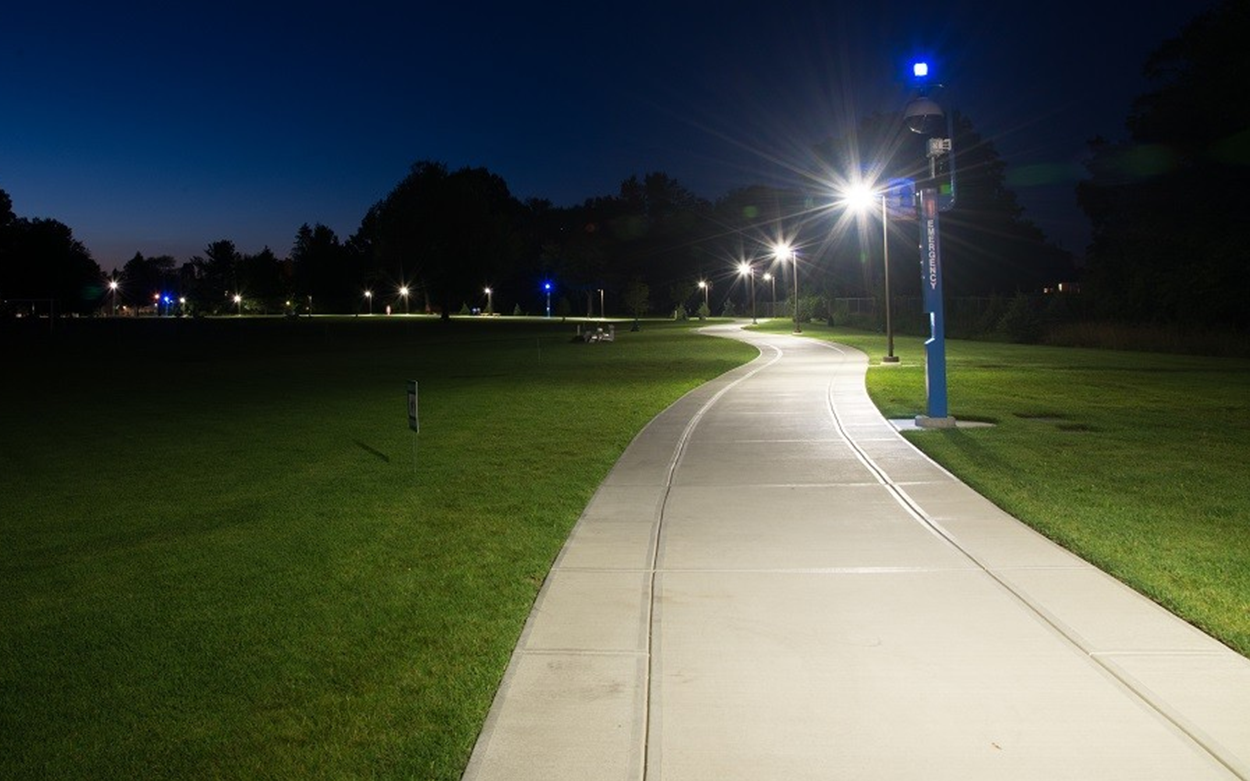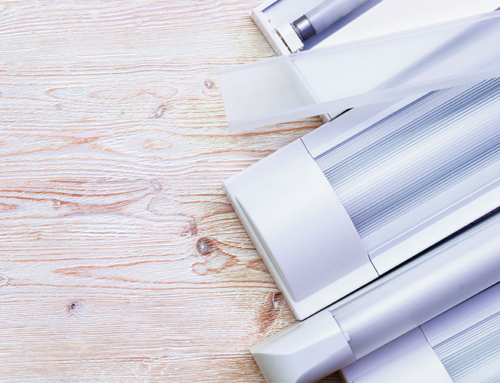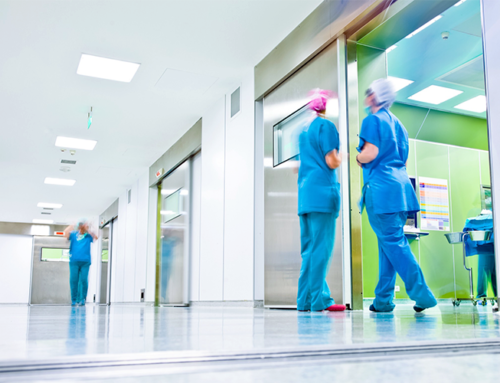
There are lots of factors that determine student success in college: good study habits, passionate instructors, valuable campus resources; these all contribute to having a positive college experience. Believe it or not, there’s another aspect of college life that is often overlooked, yet it still influences student success, and touches the lives of every student on campus: lighting.
Lighting has an abundance of applications for Universities and College Campuses – students participate in evening classes, late night lab sessions and projects, and evening social activities – so it’s important to create a well-lit, safe environment for your student body.
“A well-designed outdoor lighting system can offer environmental and financial benefits,” says John Casadonte, the product marketing manager at Cree, Inc. “Colleges and Universities typically have large outdoor spaces or pathways that require significant lighting, and parking structures are often illuminated continuously, providing major opportunities for efficiency and lower costs.” A safer environment, coupled with the desire for younger generations to learn the value of sustainable energy and reducing their carbon footprint, has created a strong desire for LED lighting at college-level institutions.
Fortunately, advancements in lighting technology, ranging from more-efficient components to increasingly sophisticated controls, along with the eagerness of energy providers to boost efficiency, offer attractive opportunities for making the most of your campus’s lighting system.
Practical Applications for Campus LED Lighting
LED lighting is practical for university and college campuses since it works so well for various installations, including: walkways, buildings, parking lots and structures, gymnasiums and admin offices. Along with providing better light quality, color rendering, and reduced energy consumption, LED light bulbs commonly last longer than 10 years, keeping maintenance costs at a minimum.
Common Areas and Walkways
Safety during evening activities and night time transitions between dorms, educational and recreational buildings is essential. On average, walkways and common areas require 12 hours (or more) of lighting per evening.
An investment in LED lights provides a great ROI as LEDs are 50% more efficient than fluorescent lights and most LEDs have a useful life of at least 50,000 hours (compared to 24,000 hours for high-pressure sodium (HPS) lamps, 15,000 hours for fluorescent lamps, and 1,000 hours for incandescents).
Parking Lots and Garage Structures

From an energy saving perspective, student and faculty parking areas are great for examining the benefits of an LED lighting system. Similar to campus walkways and common outdoor areas, parking lot light fixtures can operate continuously for upwards of 12 hours every day – and can be one of your largest energy expenses – common wattages for HID parking lot lights range from 400w to 1,000w, costing up to $525 per lamp, per year, to operate in electricity alone! In addition to potential lamp lifetime concerns, parking lot and parking structure lights often require the use of a lift or bucket truck to replace a lamp or ballast. Many campuses do not own a bucket truck or lift, and as a result, are required to hire a contractor for fixture maintenance, which can cost up to $1,200 in labor and materials to maintain just a single parking light fixture over 3 years!
Tilting away from an energy efficiency and cost-savings perspective, brighter light with better light quality helps to elevate student and faculty mood by making them feel safer. The improved lighting also provides the opportunity to take notice of, and avoid, slippery areas, irregular surfaces, curbs, wheel stops, and other features that may results in slips or trip-and-fall accidents. Reduced falls and reduced crime reduce your risk of lawsuits that occur due to crime victimization and fall injuries. Poor light quality (and poor lighting in general) is a common reason that property owners are forced to pay damages in these lawsuits.
The improved lighting also makes the parking lot or structure appear more attractive and upscale.
Campus Building Exteriors
Safety around campus doorways and windows is important. Wall pack fixtures and building flood lights can be very effective solutions when combined with LED lighting. In fact, many campuses have already started replacing lights with LED technology; John Casadonte, Cree, Inc. states, “while current technology for outdoor light fixtures—such as halogen or HID (high-intensity discharge)—offers the potential for high light output, they can be more costly than LED alternatives.” Casadonte goes on to note that some outdoor light fixtures deliver better light control and more uniform, white light than metal halide and may provide nearly maintenance-free lighting for up to 100,000 hours.
In addition, those outdoor areas previous discussed (common areas, walkways, parking lots, garage structures and campus building exteriors) tend to be lit for 24 hours a day, 7 days a week, throughout the year. With such a high demand, there is a huge potential for savings if the right technology is utilized.
Gymnasiums and Natatoriums
Since these facilities can stay open up to 20 hours on average, the energy and maintenance savings achieved through high-bay LED fixtures yields an attractive ROI. The solid-state nature of modern LEDs, and the option to remotely mount drivers or power supplies, helps to keep maintenance requirements simple in high-humidity natatoriums. And the ability to withstand severe impacts with minimal-to-no-damage makes LED high-bays are great choice to use in gymnasiums.
D.O.E.—Princeton University Case Study
A great example of the implementation of LEDs on a college campus can be found in this evaluation of exterior LED lighting retrofits at Princeton University—carried out by the U.S. Department of Energy. View the case study here.
Princeton University applied LED lighting to exterior walkways, parking lots, and parking garages; some including the application of lighting controls. The previous HID lighting system on campus used a total of 298,267 kWh of electricity per year. Once the LED lighting retrofits were installed, the system used 102,822 kWh of electricity per year, resulting in an annual savings of 195,443 kWh. Once lighting controls were factored into the equation, the savings were calculated as high as 246,995 kWh saved annually
In Conclusion
When it comes to return on investment, campus lighting may rank among the most-promising of areas. When considering available options, you should take care to select products that are based on proven technologies.
The fact remains that the application of LED lighting retrofits at colleges and universities can easily be justified as economical alternatives based on the energy and maintenance savings. In addition, the younger generations are acutely aware of the need for environmentally-friendly solutions, an LED lighting system can enhance the image of any educational institution.
If you’re looking for a way to improve the environment for your students and teachers, a lighting upgrade may be the solution. For more information, or to schedule on audit, contact the Lighting Certified specialists at Energy Performance Lighting by email or phone at (608) 661-5555, or you can click here to schedule a lighting service. Complete our simple assessment form and an EPL team member will contact you within 24 hours to discuss solutions for your building(s).



